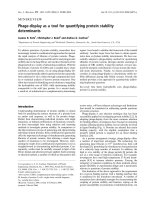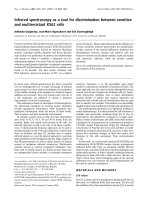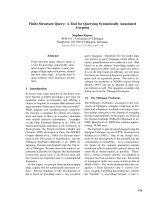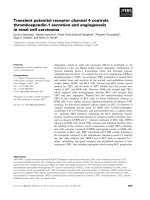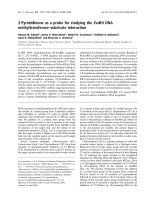Báo cáo khoa học: "Individually Coded Telemetry: a Tool for Studying Heart Rate and Behaviour in Reindeer Calves" ppt
Bạn đang xem bản rút gọn của tài liệu. Xem và tải ngay bản đầy đủ của tài liệu tại đây (349.8 KB, 10 trang )
Eloranta E, Norberg H, Nilsson A, Pudas T, Säkkinen H: Individually coded
telemetry: a tool for studying heart rate and behaviour in reindeer calves: Acta vet
scand. 2002, 43, 135-144. – The aim of the study was to test the performance of a sil-
ver wire modified version of the coded telemetric heart rate monitor Polar Vantage
NV
TM
(PVNV) and to measure heart rate (HR) in a group of captive reindeer calves dur-
ing different behaviour. The technical performance of PVNV HR monitors was tested
in cold conditions (-30°C) using a pulse generator and the correlation between gener-
ated pulse and PVNV values was high (r=0.9957). The accuracy was tested by compar-
ing the HR obtained with the PVNV monitor with the standard ECG, and the correla-
tion was significant (r=0.9965). Both circadian HR and HR related to behavioural
pattern were recorded. A circadian rhythm was observed in the HR in reindeer with a
minimum during night and early morning hours and maximum at noon and during the
afternoon, the average HR of the reindeer calves studied being 42.5 beats/min in Febru-
ary. The behaviour was recorded by focal individual observations and the data was syn-
chronized with the output of the HR monitors. Running differed from all other be-
havioural categories in HR. Inter-individual differences were seen expressing individual
responses to external and internal stimuli. The silver wire modified Polar Vantage NV
TM
provides a suitable and reliable tool for measuring heart rate in reindeer, also in natural
conditions.
heart rate; measuring technique; method; individual coding; reindeer; behaviour;
circadian.
Acta vet. scand. 2002, 43, 135-144.
Acta vet. scand. vol. 43 no. 3, 2002
Individually Coded Telemetry: a Tool for Studying
Heart Rate and Behaviour in Reindeer Calves
By E. Eloranta
1
, H. Norberg
2
, A. Nilsson
3
, T. Pudas
2
, and H. Säkkinen
2
1
Department of Physiology, and
2
Department of Biology, University of Oulu, Finland,
3
Department of Genetics,
Swedish University of Agricultural Sciences, Uppsala, Sweden.
Introduction
Changes in the environment, caused by nature
or man, stress wild animals and threaten their
well-being causing anything from discomfort to
death. The reindeer (Rangifer tarandus taran-
dus L.) is a semi-domesticated free-ranging ru-
minant living under harsh environmental condi-
tions and it is subject to a wide variety of
thermal and nutritional stressors during the nat-
ural seasonal cycle. In northern Finland, Swe-
den and Norway reindeer husbandry is an im-
portant livelihood with approx. 500000
productive animals. Reindeer management
practices, such as herding, handling, restraint,
transport and slaughtering induce additional
stress responses and may adversely affect the
animals’ welfare. Due to the rapid development
in management practices it has become impor-
tant to study the behavioural and physiological
changes associated with stress in these animals
to be able to assess their welfare.
Heart rate (HR) changes in relation to be-
haviour and the environment have earlier been
monitored e.g. in sheep (MacArthur et al.
1979), white-tailed deer (Moen 1978, Mautz &
Fair 1980), mule deer (Kautz et al. 1981), and
red deer (Price et al. 1993). The HR of the rein-
deer has been measured earlier from anaes-
thetised animals during heart catheterizations
(Timisjärvi 1978), and by using subcutaneous
electrodes connected to a graphic recorder
(Timisjärvi et al. 1979, Nilssen et al. 1984).
Mesteig et al. (2000) applied silver wire modi-
fied non-coded Polar
®
Sport Testers (PST) to
measure HR telemetrically from 2 reindeer.
However, there is still a lack of knowledge re-
lating to the HR variation and associated be-
havioural patterns of reindeer.
When studying the normal HR on a daily basis,
it is important to keep the environmental fac-
tors, such as the group structure, as constant as
possible and to minimize human activities to
prevent disturbing stimuli. To be able to evalu-
ate the stress and welfare of the animals with
HR, it has become evident that the changes in
HR over the 24-h period and also during normal
behaviour have to be monitored.
The aim of this study was to test the perfor-
mance of a silver wire modified version of a
coded telemetric HR monitor Polar
®
Vantage
NV™ (PVNV; Polar Electro Oy, Kempele, Fin-
land) and its applicability in behavioural stud-
ies. We also describe the daily rhythms of HR in
unrestrained captive reindeer calves.
Materials and methods
Animals and experimental design
The study was carried out during March 1997
and February 1998 at the Zoological Gardens of
the Department of Biology, University of Oulu
(65°04’N, 25°30’E), Finland. Reindeer calves,
aged 6 to 7 months, were brought from natural
pastures and allowed at least 2 months habitua-
tion in the Zoological Gardens prior to the ex-
periments. The calves were kept outdoors in
about 650 m
2
pens and they were offered a mix-
ture of lichen (Cladina spp.), mixed with leaves
(Salix spp.) and shrubs (Vaccinum myrtillus) ad
lib. Feeding took place twice a day: one-third of
the ration in the morning and the rest at noon.
Fresh water was available ad lib. The health sta-
tus of the reindeer was checked by the Oulu uni-
versity veterinary.
In 1997, 8 calves, weight on average 43.6 kg
(range 39.9-45.9 kg), were kept in 2 equal
groups to enable simultaneous individual ob-
servations. Prior to the study the reindeer had
taken part in an experiment involving be-
havioural studies, weighing and blood sampling
(Nilsson et al. 2000). The calves were main-
tained in their original groups (control and re-
stricted diet) of the previous study, thus the so-
cial hierarchy of the groups was established.
The HR and behaviour were monitored on 4
occasions altogether ca. 5 h including 1) a
20-min period after installation of the HR mon-
itors, 2) a 30-min undisturbed period, 3) a 60-
min period starting 15 min before feeding and
4) a 60-min period starting 15 min before a 15-
136 E. Eloranta et al.
Acta vet. scand. vol. 43 no. 3, 2002
Table 1. Definitions of different behaviour categories recorded via focal observations in the study.
Behaviour Definition
Lying Lying passively
Standing Standing passively
Locomotion Moving, walking or running
Running Constant running under human harassment
Eating Animal inside the feeding area ingesting feed or water from the grip or chewing and
masticating feed close to the feeding area
Ruminating Ruminating lying; refining a regurgitated food bolus
min running period and continuing 30 min af-
ter. Running was provoked by human harass-
ment. The behaviour of each animal in the
group was recorded by focal observations at
one-minute intervals using the categories de-
fined in Table 1. The HR and the behaviour
were connected by synchronizing the focal ob-
servation data with the output of the HR moni-
tors. In addition to the experiments with the
calves one 1.5-year-old female reindeer was
used to test the accuracy of the PVNV in Octo-
ber 1997.
In 1998 the circadian HR data of 6 calves
(weight on average 38.9 kg (range 35.8-42.1
kg)) was recorded using the PVNV. Prior to this
study these animals were treated as the control
group in an experiment conducted by Åhman et
al. (in press). HR was recorded continuously at
one-min intervals for 72-74 h and 50 consecu-
tive hours of the data were extracted for presen-
tation. The mean and mode were calculated
over one 24-h period. Circadian HR is pre-
sented as 15-min averages for 6 calves.
During trials in March 1997 the outdoor tem-
perature was, on average, -3,2ºC (-10.8 -
+3,6ºC). For 1998 the outdoor temperature is
presented in Fig. 5.
The heart rate monitoring device
The transmitter belts and the wrist receiver
monitors Polar
®
Vantage NV™ with individual
coding were installed on the reindeer calves.
The animals were restricted on the treatment
bench by hand, and no sedatives were used. Sil-
ver needle electrodes connected to the transmit-
ter were used in order to make contact with the
skin. The electrodes were inserted subcuta-
neously using local anaesthetic (Xylocain 20
mg/ml) and an 18-G needle leading the elec-
trode through a fold of the skin. The first elec-
trode was placed behind the scapula and the
second about 30 cm posterior to the first. The
pelage was cut down to 1 cm hair length on a 3
cm × 30 cm area parallel to the vertebral col-
umn and one half of a ‘rip-strip’ tape was glued
on. The transmitter was attached to the other
half of the tape. There was a joint in the middle
of the electrode lead to protect the skin in case
of external tension in the lead (Fig 1).
Telemetry in reindeer calves 137
Acta vet. scand. vol. 43 no. 3, 2002
Figure 2. The wrist monitor was attached to the
collar and the transmitter to the fur. An elastic band
was used to secure the attachment of the transmitter.
Photo by Harri Nurminen.
Figure 1. The electrodes were inserted under the
skin and the transmitter was attached to ‘rip-strip’
tape, which was placed parallel to the vertebral col-
umn. The other side of the tape was glued to the hair.
There was a joint in the middle of the wire to protect
the skin. Photo by Harri Nurminen.
In the PVNV the HR signal is telemetrically
transmitted within a range of 50 cm to the wrist
monitor, which in the present study was at-
tached to the collar (Fig. 2). The receiver mon-
itor calculates the HR, based either on the beat-
to-beat interval or a beat-to-beat time-
averaging algorithm, at 5-, 15- or 60-s intervals.
According to the manufacturer’s information
the memory capacity of the wrist monitor is 134
h with averaging at 60-s intervals. However, in
this study the maximal recording capacity ac-
quired with PVNV monitors at 60-s intervals
was only 99 h and 59 min. The HR data was
transferred to a computer by Polar Precision
Performance Software
TM
for Windows
®
(Polar
Electro Oy, Kempele, Finland) for further anal-
ysis.
Accuracy tests for heart rate measurement
Electrocardiogram (ECG) and HR measured
with PVNV were compared in one 1.5-year-old
female reindeer. The electrocardiogram was
recorded with a three channel direct-writing
recorder (Mingograph Minor 3, Siemens-El-
ema, Stockholm). The standard limb leads I, II
and III and the augmented unipolar limb leads
aVR, aVL, and aVF were recorded with subcu-
taneous needle electrodes. The reindeer was se-
dated with Zalopine (Orion, Finland, 10 mg/ml;
50 µg/kg BW) and the pulse rate during anaes-
thesia was increased with adrenalin i.v. (10
mg/ml; 50 µg/kg BW). Antisedan (Orion, Fin-
land, 5 mg/ml; 200 µg/kg BW) was used as the
antidote for the anaesthetic and ECG recording
was continued until the animal recovered. Si-
multaneously with ECG recording the PVNV
transmitter and the wrist monitor were used to
record the HR data at 5-s intervals to compare
this data with the ECG. To investigate whether
the variations in PVNV values reflect the vari-
ability in beat-to-beat variation, a period of 80
successive beat-to-beat intervals was extracted
from the ECG data and the intervals were com-
pared.
To test the accuracy of the PVNV in cold tem-
peratures, the technical performance of 8
PVNV receiver monitors was tested according
to the method described by Hopster and
Blokhuis (1994). Each monitor was exposed to
a temperature of -30°C in a freezer, and to room
temperature (20°C). The transmitter was con-
nected to a pulse generator, which generated an
electrical pulse with an amplitude of 2 mV and
duration of 70 ms. The frequency of the pulse
could be varied manually from 0 to 500 beats
per minute (bpm). Each monitor computed the
average HR values at 5-s intervals. The fre-
quency of the simulated heartbeat was adjusted
stepwise according to Fig. 3.
Statistical analysis
Relationships between monitor performances
at different temperatures and between the ECG
and PVNV equipment were described using
Pearson’s correlation coefficient. Differences in
HR between behaviour categories were com-
pared by calculating behaviour-specific means
for each animal, and after log-transformation,
running one-way ANOVA followed by Tukey
test post hoc. HR values 20 min after installa-
tion were excluded from the behaviour-specific
analysis, because the installation interfered
with the behaviour and increased the HR of the
study animals. Statistical testing was carried
out using SPSS statistical software.
Results
Accuracy
Data from ECG recording was processed using
the QRS complex, which represents ventricular
activity, and measuring the consecutive RR-in-
tervals in milliseconds. The RR-interval mea-
sured by ECG correlated significantly (r=
0.9965) with the values measured by PVNV.
The generated pulse rate values and respective
PVNV values during the cold trial were also
138 E. Eloranta et al.
Acta vet. scand. vol. 43 no. 3, 2002
Telemetry in reindeer calves 139
Acta vet. scand. vol. 43 no. 3, 2002
Figure 3. Generated pulse rate (solid line) and respective pulse rates measured using PVNV (dotted line) in
the cold (-30°C). PVNV (n=8) followed stepwise changes of the generated pulse rate with a small lag, but with
high association as measured by the correlation coefficient.
Figure 4. The heart rates of 8 reindeer calves in relation to different behaviour categories. Data for each be-
haviour category has been calculated as an average of individual mean values. The box-plot presentation shows
the standard median, and 10, 25, 75 and 90 percentiles. The square plot presents the average and the outermost
plots 1 and 99 percentiles, and minimum and maximum values, respectively.
highly correlated (r=0.9957; Fig. 3). The equip-
ment coded the pulse rate with the same accu-
racy both in the cold (-30°C) and at room tem-
perature (r=0.9999).
Behavioural studies
The average HR in running was 146 bpm, in lo-
comotion 52 bpm and in other behaviour cate-
gories between 42-49 bpm. HR in running was
significantly (p<0.001) higher compared to HR
in all other behaviour categories (Fig. 4). The
mean HR and the standard deviation of HR as-
sociated with ruminating were lowest of all the
studied behaviour categories. Individual varia-
tion in HR was observed throughout the study.
The recovery time of HR after the provoked
running varied individually between 2-12 min.
Circadian heart rate variation
The peaks in circadian HR, i.e. in 24-hour
rhythm, were observed around noon, whereas
HR was lowest in the early morning hours (Fig.
5). HR fluctuation reflected the level of activity,
with the peaks being related especially to feed-
ing times. The circadian HR recorded from six
calves during one day on February 10
th
1998
was on average 42.5 beats min
-1
. The mode of
those 8640 HR values (one value/animal/min)
recorded was 35 beats min
-1
. This means that
the frequency distribution of circadian HR-val-
ues was skewed, low values being dominant.
Discussion
Only a few techniques are available for moni-
toring the HR of free-ranging animals and the
literature about the reliability of HR meters un-
der field conditions is scarce. In this study the
140 E. Eloranta et al.
Acta vet. scand. vol. 43 no. 3, 2002
Figure 5. The average heart rate of 6 female reindeer calves measured with the PVNV. The dots are represented
at 15-min intervals as an average of 15 measurements per animal. The original heart rate data was collected at
one-min intervals. Heart rates were recorded during the weekend of 9-11 February 1998 at the Zoological Gar-
dens of the University of Oulu. The total time span is 50 h. The ambient temperature during the study is pre-
sented with a dotted line.
PVNV was tested at +20 and –30°C and no dif-
ference in accuracy was observed due to the
temperature. A clear time lag was observed be-
tween the generated pulse rate and the PVNV
values, indicating a gradual adaptation to
changes in generated pulse rate. PVNV adjusts
to changes in the pulse rate in about 5 s but the
lag varies with the pulse rate. The correlation
was 0.9957, which was slightly higher than the
correlation measured by Hopster and Blokhuis
(1994).
PVNV HR monitors operate on the recognition
of the QRS complexes of the ECG. Earlier stud-
ies have shown that telemetric HR meters pro-
vide valid readings on both precision and accu-
racy in children and adults in a wide variety of
exercise, and also that the system is not signifi-
cantly affected by electrical noise artefacts or
muscle contraction (Karvonen et al. 1984,
Treiber et al. 1989, Seaward et al. 1990). In this
study, values from the tested PVNV monitors
correlated significantly with the HR measured
from the standard ECG in the reindeer. The
suitability of a modified version of the Polar
®
Sport Tester (PST) with stainless steel plate
electrodes has been tested successfully in the
horse (Ewans & Rose 1986, Sloet van Ol-
druitenborgh-Oosterbaan et al. 1988) and
dairy cows (Hopster & Blokhuis 1994). PST
with plate electrodes has been applied on the
reindeer as well (Nilsson unpubl.). In these
studies some problems with proper skin contact
in moving animals have been reported. Re-
cently a silver wire modified PST was used in
reindeer (Mesteig et al. 2000). To our knowl-
edge the use of a coded PVNV monitor has not
been published before in fur coated animals.
The correlation between ECG and PST monitor
has been shown to decrease in exercise which,
according to Hopster & Blokhuis (1994), is due
to movements of the plate electrodes on the
skin. When using plate electrodes, up to 30% of
the data has been lost due to poor skin-electrode
contact (Baldock et al. 1987, Price et al. 1993).
The use of plate electrodes demands contact on
the bare skin and wetting of the electrodes or
electrode gel is required. This method exposes
the skin to frostbite in a cold environment. The
advantage of subcutaneous electrodes was
demonstrated in this study since only 2% of the
data was missing either due to poor skin-elec-
trode contact or problems in transmitting the
signal. In addition no frostbite was observed
and minor skin damage was found only in one
study animal. Right after the installation of the
HR monitors reindeer were seen to shake them-
selves and try to lick the transmitter, but no fur-
ther disturbance due to the equipment was ob-
served. The silver needle electrodes used in this
study proved to be a practical solution taking
into account both the contact performance and
function in the cold environment.
Great care should be exercised when preparing
and installing the wires for silver electrodes. In
nine cases of all individual observation periods
(28%) the data was lost due to equipment re-
lated problems. Typically the wires were broken
due to the non-elastic material, which did not
tolerate continuous back-and-forth movement.
Alternatively, the reindeer were seen to lick and
chew the wires. These problems were reduced
by switching the wires to silicon-coated mate-
rial, which was more flexible and easier to hide
in the fur. The method has been further im-
proved by developing a harness including both
the transmitter and the receiver with the wires
inside.
Earlier studies on cows have shown that moni-
tors located at 0º and 180º angles to the trans-
mitter do not receive the signal properly, but do
at other angles (Hopster & Blockhuis 1994). In
the present study the monitors were attached to
the collar close to the 0º angle in relation to the
transmitter, but there were only occasional
problems in receiving the signal. The individual
coding of the monitor was also lost a few times.
Telemetry in reindeer calves 141
Acta vet. scand. vol. 43 no. 3, 2002
HR as a study parameter was successfully re-
lated to different behaviour patterns in the pre-
sent study. In addition to behaviour-associated
changes in HR, inter-individual differences in
animals’ responses were also seen. Individual
variations in HR levels and recovery times were
pronounced during and after human distur-
bance, but were substantially reduced during
ruminating. Respective results have earlier
been presented by MacArthur et al. (1979) in
bighorn sheep (Ovis canadensis). Both low in-
ter-individual and within-individual variation
in HR levels related to ruminating probably re-
sulted from low sympathetic and increased
parasympathetic activity during this behaviour.
In the present study the environmental stress
was minimized because of the animals’ adapta-
tion to the daily routines of the Zoological Gar-
dens. Also, the social hierarchy of the groups
was well-established prior to the study.
The present results show that there is a circa-
dian rhythm in the HR of reindeer with a mini-
mum occurring during the night and early
morning and maximum at noon and during the
afternoon. This pattern supports the idea that
the reindeer is a diurnal species. According to
Collins & Smith (1989) reindeer in the Seward
Peninsula, Alaska, allocated more time for rest-
ing during the night than during the day in
February-March. Also Erkinaro et al. (1983)
observed a similar pattern in the activity of
semi-domestic reindeer in Finnish Lapland.
These results on circadian activity budgets are
in good accordance with HR data presented in
this study where the average HR was lower dur-
ing night hours. The clear increase in HR by
noon in the present study was associated with
enthusiasm and locomotion activity at the feed-
ing places during feeding at fixed times. This
presumably does not reflect the actual activity
level in nature at these times. However, the
cyclic rhythmicity recorded in HR corresponds
to the 24-h activity observations obtained from
natural grazing conditions (Erkinaro et al.
1983, Collins & Smith 1989).
Except for the elevated HR due to feeding ac-
tivity, increased HR subsequent to feeding may
also reflect increased blood flow to the gas-
trointestinal system (von Engelhardt & Hales
1977). Mesteig et al. (2000) have shown that
there is a positive correlation in long term vol-
untary food intake and HR in the reindeer. Our
results of circadian HR recorded in February
correspond with winter values presented in ear-
lier studies (Nilssen et. al. 1984, Fancy & White
1986). In this study no association was ob-
served between HR and changing outdoor tem-
perature (Fig. 5). This is in agreement with Bal-
dock et al. (1988) who found that in sheep the
correlation of HR was better with photoperiod
than with temperature. However, climatic con-
ditions have been shown to affect behaviour
patterns in growing cattle (Redbo et al. 1996),
which may lead to different HR levels. In addi-
tion to the circadian and circannual rhythms en-
vironmental factors must also be considered
when interpreting HR measurements in rein-
deer.
The present results indicate that the telemetric
Polar
®
Vantage NV™ HR monitor, which has
been developed to record HR in humans doing
sport or exercise, is also suitable for HR mea-
surements in the reindeer in field conditions.
The advantage that the present method offers is
the possibility to study animal behaviour and
HR variation with minimal human disturbance.
Furthermore, the individual coding provides a
new tool for monitoring individual HR in groups
of animals simultaneously. This equipment pro-
vides a useful tool for monitoring the animals’
responses to different environmental stimuli and
e.g. energy expenditure in natural conditions.
However, when employing HR as a measure-
ment, great care should be emphasised in inter-
preting the results, since a wide variety of fac-
tors, both internal and external, affect the HR.
142 E. Eloranta et al.
Acta vet. scand. vol. 43 no. 3, 2002
Acknowledgements
The Committee on Animal Experiments of the Uni-
versity of Oulu, Finland, approved the experimental
procedures and handling of the animals. The authors
gratefully acknowledge Polar Electro Oy (Kempele,
Finland) for providing the heart rate monitors for the
study. Special thanks are directed to Polar Electro’s
research manager Raija Laukkanen, who corre-
sponded with the study and gave valuable comments
for the manuscript. We greatly appreciate technical
expertise of Mr. Jari Ylönen in modifying the heart
rate monitors for reindeer, and Dr. Jouni Timisjärvi in
ECG measurements. Our warmest thanks also to the
staff of the Zoological Gardens for their assistance
and animal care during the study.
References
Baldock NM, Penning PD, Sibly RM: A system for
recording sheep ECG in the field using a minia-
ture 24-h tape recorder. Comput. Electron. Agric.
1987, 2, 57-66.
Baldock NM, Sibly RM, Penning PD: Behaviour and
seasonal variation in heart rate in domestic sheep
Ovis aries. Anim. Behav. 1988, 36, 35-43.
Collins WB, Smith TS: Twenty-four hour behaviour
patterns and budgets of free-ranging reindeer in
winter. Rangifer 1989, 9(1), 2-8.
von Engelhardt W, Hales JRS: Partition of capillary
blood flow in rumen, reticulum and omasum of
sheep. Am. J. Physiol. 1977, 232, E53-E56.
Erkinaro E, Heikura K, Lindgren E, Pulliainen E,
Sulkava S: Studies on the daily activity of semi-
domestic reindeer (Rangifer tarandus L.) and
wild forest reindeer (R. t. fennicus Lönnb.) in
eastern Finland. Acta Zool. Fennica 1983, 175,
29-31.
Evans DL, Rose RJ: Method of investigation of the
accuracy of four digitally-displaying heart rate
meters suitable for use in the exercising horse.
Equine Vet. J. 1986, 18(2), 129-132.
Fancy SG, White RG: Predicting energy expenditures
for activities of caribou from heart rates. Rangifer
1986, Special Issue 1, 123-130.
Hopster H, Blokhuis HJ: Validation of a heart-rate
monitor for measuring a stress response in dairy
cows. Can. J. Anim. Sci. 1994, 74, 465-474.
Karvonen J, Chwalbinska-Moneta J, Säynäjäkangas
S: Comparison of heart-rates measured by ECG
and microcomputer. Physician Sportmed. 1984,
12(6), 65-69.
Kautz MA, Mautz WW, Carpenter LH: Heart rate as a
predictor of energy expenditure of mule deer. J.
Wildl. Manage. 1981, 45, 715-720.
MacArthur RA, Johnston RH, Geist V: Factors influ-
encing heart rate in free-ranging bighorn sheep: a
physiological approach to the study of wildlife
harassment. Can. J. Zool. 1979, 57, 2010-2021.
Mautz WW, Fair J: Energy expenditure and heart rate
for activities of white-tailed deer. J. Wildl. Man-
age. 1980, 44, 333-342.
Mesteig K, Tyler NJC, Blix AS: Seasonal changes in
heart rate and food intake in reindeer (Rangifer
tarandus tarandus). Acta Physiol. Scand. 2000,
170, 145-151.
Moen AN: Seasonal changes in heart rates, activity,
metabolism, and forage intake of white-tailed
deer. J. Wildl. Manage. 1978, 42(4), 715-738.
Nilssen KJ, Johnsen HK, Rognmo A, Blix AS: Heart
rate and energy expenditure in resting and run-
ning Svalbard and Norwegian reindeer. Am. J.
Physiol. 1984, 246, 963-967.
Nilsson A, Danell Ö, Murphy M, Olsson K, Åhman B:
Health, body condition and blood metabolites in
reindeer after submaintenance feed intake and
subsequent feeding. Rangifer 2000, 20(4), 187-
200.
Price S, Sibly RM, Davies MH: Effects of behaviour
and handling on heart rate in farmed red deer.
Appl. Anim. Behav. Sci. 1993, 37, 111-123.
Redbo I, Mossberg I, Ehrlemark A, Ståhl-Högberg
M: Keeping growing cattle outside during winter:
behaviour, production and climatic demand.
Anim. Sci. 1996, 62, 35-41.
Sloet van Oldruitenborgh-Oosterbaan MM, Van den
Hoven R, Breukink HJ:
The accuracy of three dif-
ferent heart-rate meters used for studies in the ex-
ercising horse. J. Vet. Med. Ser. A 1988, 35, 665-
672.
Seaward BI, Sleamaker RH, McAuliffe T, Clapp JF:
The precision and accuracy of a portable heart
rate monitor. Biomed. Instr. Techn. 1990, 24, 37-
41.
Timisjärvi J: The blood circulation of the reindeer.
Acta Univ. Oul. D 36 1978. Pharmacol. Physiol.
7, 45+42 pages.
Timisjärvi J, Hirvonen L, Järvensivu P, Nieminen M:
Electrocardiogram of the reindeer, Rangifer
tarandus tarandus. Laboratory Animals 1979, 13,
183-186.
Treiber FA, Musante L, Hartdagan S, Davis H, Levy
M, Strong WB: Validation of a heart rate monitor
with children in laboratory and field settings.
Med. Sci. Sports Exerc. 1989, 21(3), 338-342.
Telemetry in reindeer calves 143
Acta vet. scand. vol. 43 no. 3, 2002
Åhman B, Nilsson A, Eloranta E, Olsson K: Wet-
belly in reindeer (Rangifer tarandus tarandus) in
relation to body condition, body temperature and
blood constituents. Acta Vet. Scand. (in press).
Sammanfattning
Individrelaterad telemetri: ett verktyg vid studier av
hjärtfrekvens och beteende hos renkalvar
Syftet med studien var att testa en silvertrådsmodifi-
erad version av en kodad telemetrisk hjärtfrekvens-
mätare Polar Vantage NV
TM
(PVNV), och att mäta
hjärtfrekvens vid olika beteende hos en grupp häg-
nade renar. Den tekniska prestanda av PVNV mätare
testades i kyla (-30°C) med en pulsgenerator och
korrelationen mellan genererad puls och PVNV vär-
den var hög (r=0.9957). Exaktheten hos PVNV mä-
tare testades genom att jämföra uppmätt hjärtfre-
kvens med standard EKG och korrelationen var sig-
nifikant (r=0.9965). Såväl mönster i hjärtfrekvens
som hjärtfrekvens relaterad till olika beteende stude-
rades. Ett återkommande mönster i hjärtfrekvens ob-
serverades hos renar med minimum under natten och
tidiga morgon timmar och maximum mitt på dagen
och eftermiddagen, genomsnittet var 42.5 slag per
minut för de studerade renkalvarna i februari. Dju-
rens beteende studerades genom individuella fokal
observationer och resultaten synkroniserades med
värden från PVNV mätarna. Hjärtfrekvens när djuren
sprang skilde sig från övriga beteende kategorier. In-
omindividuella skillnader observerades och sågs som
uttryck för olika individers respons på externa och in-
terna stimuli. Den silvertrådsmodifierade versionen
av Polar Vantage NV
TM
är en lämplig och tillförlitlig
metod för att mäta hjärtfrekvens hos renar, även un-
der naturliga förhållande.
144 E. Eloranta et al.
Acta vet. scand. vol. 43 no. 3, 2002
(Received April 27, 2002; accepted May 13, 2002).
Reprints may be obtained from: Harri Norberg, Finnish Game and Fisheries Research Institute, Reindeer Re-
search Station, Fin-99910 Kaamanen, Finland. E-mail: harri.norberg@rktl.fi, tel: (+358) 400 343 303; 0400 343
303 (in Finland), fax: (+358) 205 751 829; 0205 751 829 (in Finland).



